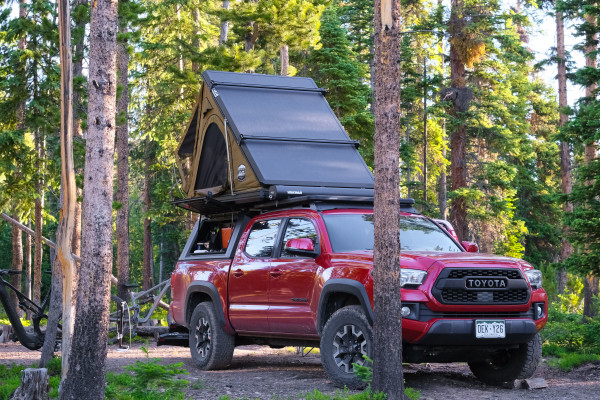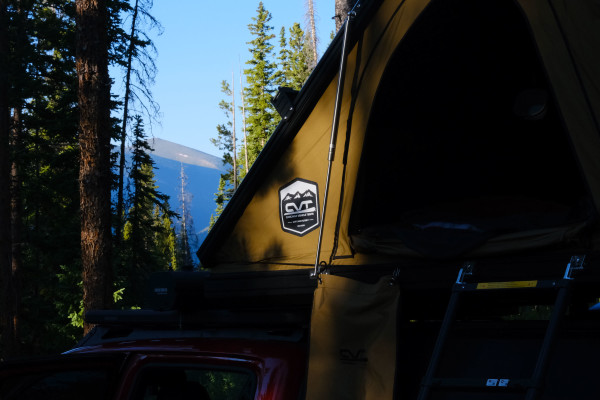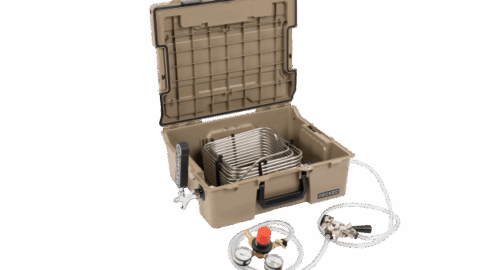And it does indeed take up most of the space on top of my 2019 Toyota Tacoma TRD Off-Road, which is outfitted with an RSI SmartCap. Fortunately, CVT understands its customers well: The real estate on top of the Mt. Hood is usable too when you mount CVT’s load bars on it.
In terms of comfort, construction, and versatility, the Mt. Hood proves itself an excellent rooftop tent. But it’s not as spacious inside as I was expecting, which is a little disappointing given its external size.
Still, if you’re after a rooftop tent that will help you get a great night’s sleep over multiple-day trips, and you need your tent to stand up to the rigors of real overlanding, the CVT Mt. Hood is a burly, comfy option that will make the investment of money and roof space worthwhile.
Rating
4
Specs
Weight: 205 pounds (size medium)
Dimensions: 56 x 85x 8.25 inches
Interior dimensions: 53 x 81 x 56 inches
Mattress depth: 3 inches
Buy it here
What I like
Excellent mattress; lots of versatility; cool accessories
What I’d change
Would love the interior to be more spacious
My call
The CVT Mt. Hood Rooftop Tent is rugged and durable, and it’s smartly designed to accept a ton of accessories easily. The mattress is one of the most comfortable rooftop tent mattresses I’ve tested, too. It’s big and heavy, however, so be sure your vehicle can handle the bulk. If you’re after a tough, versatile, and comfortable rooftop tent, the CVT Mt. Hood might be your next overlanding apartment.
CVT Mt. Hood Price and availability

The CVT Mt. Hood is available for purchase now through CVT’s website. It costs $2,999 and includes free shipping.
CVT also offers flexible payment options through Bread Pay, if you’d like to break up the big purchase into smaller payment installments.
CVT Mt. Hood Design and build

I tested the size medium Mt. Hood tent, but there are small and large options as well. You can also choose between three color options (this applies to the tent material, not the aluminum shell, which is black no matter what you choose): Black, Tan, and Gray.
The aluminum shell closes down to 8.25 inches thick, which is fairly thin, though not the thinnest on the market (Check out our review of the Roofnest Falcon 3 EVO coming soon).
When it’s closed up, there’s a 1.5-inch gap inside, meaning you can leave your sleeping bag in there, or stow other low-profile goodies.
Inside, CVT includes a 3-inch mattress with a poly/cotton cover. The ceiling is fabric-covered too. There are lots of storage pockets inside to stow your goodies, and the tent also includes shoe bags you can hang inside or outside the tent to keep your dirty kicks off the mattress.

This is a four-season tent, equipped with mosquito netting that allows plenty of airflow when you want it, and fabric doors when you want to close up shop completely. The latter also block out the sun, so you can sleep in late if you want to.
The outside perimeter of the Mt. Hood features dual T-slots, making it easy to mount accessories like an awning or a shower. These also allow you to customize placement of latches, handles, ladder mounts, and other hardware. The crossbars that were included with my test sample also mount into the channels.
The tent itself includes a rain awning that extends off the back of the tent. These get extended using included awning poles, which slot into stops you will secure to the T-slots.
All told, the size medium Mt. Hood weighs 205 pounds.
Mounting and unmounting the CVT Mt. Hood

Since the Mt. Hood is quite large and heavy, it took four people to get it on top of my truck. It wasn’t the easiest process, but with an aluminum-shell tent like this, I don’t expect to be installing/uninstalling frequently. A few beers to entice a few buddies over worked out just fine.
The mounting hardware that secures the tent to the load bars on my truck is sufficient, though it isn’t as nice or fancy as something like Thule’s mounting system, which includes locks and makes it super easy to secure the tent in just seconds. The included bolts with the CVT hardware were quite long, so it boiled down to a few 13mm box wrenches and patience.
Keep in mind that the tent is long at 85 inches, so you’ll want to ensure your load bars are spaced widely enough to support the tent’s length. As it is, my load bars left a gap of unsupported tent at the front, leading to some movement that led to knocking as I drove and hit bumps. I’ll need to solve that problem for longterm use.
Sleeping in the CVT Mt. Hood

I spent my first night in the CVT Mt. Hood outside Winter Park, Colorado, up some long dirt roads to get away from the riff-raff. While driving up the rough road, I did hear some knocking from above, which is, again, due to my load bars not being spaced far enough apart. The rack above my cab left a gap of about one inch between the rack and the tent. I’ll need to figure out a solution here, but heed my mistake here. Be sure your vehicle is set up to support a tent this large.
Once I arrived at my campsite, setup took seconds. Just pop the latches and push the handle. The hydraulic struts will do the rest of the work. You can leave it at that, or you can climb in and attach the poles that support the small awning at the back of the tent.
I did the latter. The poles slot into hardware you mount in the T-slots. I don’t love this system; the mounting hardware is soft aluminum, and the poles ended up damaging them pretty quickly. And it took a while to find the right position that held the awning out properly. This part of the tent could definitely use some streamlining, but once it’s set up, it’s a nice feature and easy to forget about.

Inside, the mattress is super comfortable. It is, in fact, among the most comfortable tent mattresses I’ve tested. Kudos to CVT for thinking about my sore back after a long day of playing in the woods.
I’m a big fan of the storage inside the tent. A lot of rooftop tents skip this part, and it can be maddening to have all your loose goods on the mattress itself. Multiple pockets make organization easy in the Mt. Hood. And the shoe pockets hanging outside, next to the ladder, make it even easier to keep the inside of your tent clean.
I did find the overall living space within the Mt. Hood to be smaller than I expected, given its large footprint outside. It’s not exactly cramped, but it’s certainly not as spacious as the Roofnest Falcon 3 EVO XL I am currently testing, which extends the tent material upward and outward to maximize living space within.
My feet touched the lowest part of the tent when I was lying completely laid out flat. I could scoot toward the taller part of the tent to give myself more space, but if you’re over six feet tall, you might find yourself a bit cramped here.
The mosquito netting is plentiful, and it allowed me to get a ton of airflow through the tent without inviting in my least-favorite camping company. If you choose to close up the doors completely, you’ll be left with a very dark setting, which is great if you’d like to sleep in past sunrise.
All of my nights spent in the Mt. Hood have been exceptionally comfortable due to the excellent mattress. It will sleep two adults comfortably. I wouldn’t really recommend this size for more than two adults, however.
CVT Mt. Hood key accessories

I really love that CVT includes load bars that mount on top of the tent. While mounting items here will obviously add more height to your vehicle, it also allows you to haul what you otherwise would have mounted on your roof if you didn’t have the tent there. They’re very adjustable and easy to mount, and I can see using these load bars for solar panels, cargo boxes, or even a canoe or kayak.
The awning brackets are a must-have if you own an awning that’s not from CVT. I have a Yakima Major Shady, and the Yakima brackets didn’t play nice with the CVT T-channels on the Mt. Hood. So CVT send me the awning brackets, which made it a breeze to install my awning. It feels stable and solid mounted to the T-rails on the tent.
One accessory I have not tested, but really want to, is the CVT Mt. Hood Insulated Liner. This $325 addition adds warmth to the inside of the tent so you can comfortably use your Mt. Hood in colder weather. If you’ll be camping year round, consider this a must-have.
CVT Mt. Hood Verdict


It’s not the most spacious rooftop tent, which is disappointing given its external dimensions. But The Mt. Hood shines in almost every other aspect. The mattress is among the most comfortable rooftop tent mattresses we’ve tested, and the overall construction of the Mt. Hood rooftop tent is burly, and ready for the roughest adventures you can throw at it.
Deploying the tent and stowing it after use is super easy thanks to the bungee cord that wraps around the tent material. And the hydraulic struts lift the lid quickly, quietly, and with minimal effort.
The poles that hold up the rear awning are a minor weakness. For a tent that’s so refined everywhere else, the poles feel like an afterthought and I didn’t enjoy wrestling them into place.
But that’s really the most significant weakness of the Mt. Hood, which basically means there aren’t many weaknesses. It’s clear the CVT Mt. Hood is built to last through use and abuse on overlanding trips for years. If you’re looking for a rugged hardshell rooftop tent, the Mt. Hood is a great option. But if you can’t sacrifice all of your roof’s real estate, or need heaps of living space within the tent, you might look elsewhere.


